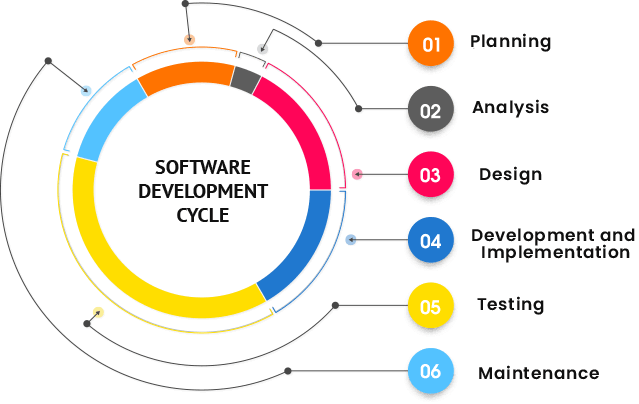Software Development

What is software development?
Software development is the process programmers use to build computer programs. The process, also known as the Software Development Life Cycle (SDLC), includes several phases that provide a method for building products that meet technical specifications and user requirements.
The SDLC provides an international standard that software companies can use to build and improve their computer programs. It offers a defined structure for development teams to follow in the design, creation and maintenance of high-quality software. The aim of the IT software development process is to build effective products within a defined budget and timeline.
Key steps in the software development process
There are six major steps in the software development life cycle, including:
- Needs identification
- Requirement analysis
- Design
- Development and implementation
- Testing
- Deployment and maintenance
1. Needs identification
Needs identification is a market research and brainstorming stage of the process. Before a firm builds software, it needs to perform extensive market research to determine the product’s viability. Developers must identify the functions and services the software should provide so that its target consumers get the most out of it and find it necessary and useful. There are several ways to get this information, including feedback from potential and existing customers and surveys.
The IT teams and other divisions in the company must also discuss the strengths, weaknesses and opportunities of the product. Software development processes start only if the product satisfies every parameter necessarily for its success.
2. Requirement analysis
Requirement analysis is the second phase in the software development life cycle. Here, stakeholders agree on the technical and user requirements and specifications of the proposed product to achieve its goals. This phase provides a detailed outline of every component, the scope, the tasks of developers and testing parameters to deliver a quality product.
The requirement analysis stage involves developers, users, testers, project managers and quality assurance. This is also the stage where programmers choose the software development approach such as the waterfall or V model. The team records the outcome of this stage in a Software Requirement Specification document which teams can always consult during the project implementation.
3. Design
Design is the third stage of the software development process. Here, architects and developers draw up advanced technical specifications they need to create the software to requirements. Stakeholders will discuss factors such as risk levels, team composition, applicable technologies, time, budget, project limitations, method and architectural design.
The Design Specification Document (DSD) specifies the architectural design, components, communication, front-end representation and user flows of the product. This step provides a template for developers and testers and reduces the chances of flaws and delays in the finished product.
4. Development and implementation
The next stage is the development and implementation of the design parameters. Developers code based on the product specifications and requirements agreed upon in the previous stages. Following company procedures and guidelines, front-end developers build interfaces and back-ends while database administrators create relevant data in the database. The programmers also test and review each other’s code.
Once the coding is complete, developers deploy the product to an environment in the implementation stage. This allows them to test a pilot version of the program to make performance match the requirements.
5. Testing
The testing phase checks the software for bugs and verifies its performance before delivery to users. In this stage, expert testers verify the product’s functions to make sure it performs according to the requirements analysis document.
Testers use exploratory testing if they have experience with that software or a test script to validate the performance of individual components of the software. They notify developers of defects in the code. If developers confirm the flaws are valid, they improve the program, and the testers repeat the process until the software is free of bugs and behaves according to requirements.
6. Deployment and maintenance
Once the software is defect-free, the developers can deliver it to customers. After the release of a software’s production version, the IT software development company creates a maintenance team to manage issues clients encounter while using the product. Maintenance can be a hot-fix if it is a minor issue but severe software failures require an update.
Types of software
Software belongs to three main groups based on their use and application. Here are the popular categories of software.
1. System software
Also called operating system or OS, system software is the program your computer uses to translate input commands into machine-readable language. The operating system controls a computer’s hardware components.
Examples of popular operating systems used in personal computers include the Windows OS from Microsoft, Mac OS used in Apple MacBook and the Linux-based Ubuntu. Web servers use the Apache OS while the UNIX operating system is used to build proprietary systems.
2. Application software
This is the application most people use to perform tasks on their computers and smartphones. Popular examples include word processing apps, internet browsers, media players, photo editing tools, anti-virus and even software-as-service (SAS) products.
3. Programming languages
This is the programming language used to create software. It is used only by coders to create programs. Programming languages include Java, C++, PHP and Simlab.


